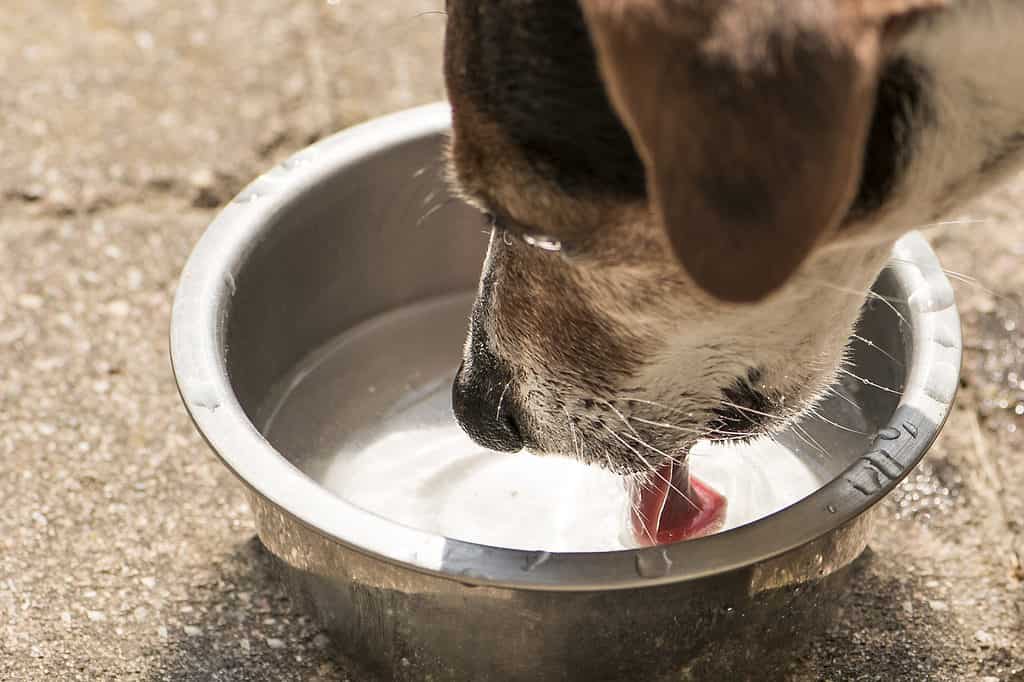Many people have experienced a UTI, or urinary tract infection, at least once. But our furry friends are also susceptible to these uncomfortable infections. While humans can easily go to the doctor for diagnosis and treatment, it may be more challenging to decipher what your dog needs. However, UTIs in dogs are fairly common and relatively easy to diagnose and treat. But you also want to ensure they get treatment promptly to prevent more severe complications. Find out what signs to look for, how to treat them, and how to prevent UTIs in dogs.
What Can Cause UTI in Dogs?

E. coli bacteria is the most common cause of UTIs in dogs.
©Gorodenkoff/Shutterstock.com
There are several ways a dog can develop a urinary tract infection, but bacteria are the primary cause. E. coli is the most common bacteria to infect dogs. However, other organisms can be involved. Bacteria from feces and other debris can enter the urethra and travel to the bladder, where it grows and reproduces. Other less common and more severe causes of UTI include bladder disease, kidney disease, kidney stones, diabetes, cancer, prostate disease, and several more. Older females and those with sugar diabetes or bladder stones are predisposed to UTIs. And dogs who are obese are also more likely to develop bacteria in their bladder without producing symptoms.
Now that you know the causes of UTIs in dogs, find out what signs and symptoms you should look for.
Signs and Symptoms of UTIs in Dogs

Look for changes in your dog’s bathroom behavior, including accidents in the house, dripping urine, and painful urination.
©iStock.com/lolostock
One of the best ways to tell if your dog has a UTI is to look for changes in their bathroom behavior and routine. Do they need to be let out more frequently? Are they dripping urine or whining in pain when they need to relieve themselves? UTI symptoms in dogs are not that different from humans. But it is essential to pay attention to your dog’s cues and emotional and physical state.
Here are some of the most common signs and symptoms of UTIs in dogs:
- Accidents in the house
- Needing to be let outside more frequently
- Dripping urine with a strong smell
- Cloudy or bloody urine
- Whimpering or physical distress during urination
- Excessive licking around the urethra
- Fever (you can check this with a rectal thermometer)
A urinalysis from a veterinarian is the only definitive way to determine whether your dog has a UTI. These tests can also rule out other conditions like stones, diabetes, and more.
How Can I Treat My Dog’s UTI at Home?

Dogs can eat cranberries, and they can have a positive effect on bladder and urinary health. Just be aware that they should only be given in small quantities.
©iStock.com/gitusik
Here at AZ Animals, we always encourage our readers to seek professional help from qualified physicians for anything medical-related. Leaving a UTI untreated can lead to more severe complications, such as stones, kidney infections, infertility, and kidney failure.
Combined with a vet’s treatment, here are some things you can do to help your dog at home:
- Cranberry extract has been shown to have a slight effect on bladder and urethra health. You can also try supplements and fresh cranberries in small quantities.
- Provide your dog with plenty of water. Your furry friend should always have a fresh, clean water supply.
- Add one teaspoon of apple cider vinegar to your dog’s water bowl. ACV is excellent for urinary and digestive health.
- Add raw fruits, vegetables, and a dollop of yogurt to your dog’s diet. These foods can help with UTI symptoms.
While these tips can improve your dog’s urinary health, it’s essential to schedule a visit with your dog’s veterinarian if symptoms don’t improve within 48 hours. The presence of harmful bacteria will most likely need to be treated with prescribed antibiotics. And if your dog has recurring UTIs, you may need to screen for other conditions.
How to Prevent UTI in Dogs

Provide plenty of clean, fresh water to prevent UTIs in dogs.
©iStock.com/K_Thalhofer
Providing plenty of clean, fresh water is one of the best ways to prevent UTIs in dogs. Be sure to change the water bowl frequently, especially once you see bits of food and saliva floating around.
Allowing your dog frequent opportunities for outside time ensures they can relieve themselves when needed. Holding urine for hours and hours is not optimal for bladder and urethral health.
You should also check the urethra opening for any debris, feces, scratches, and other injuries. Keeping this area clean can prevent future infections. Consider using antibacterial wipes.
And finally, take your pet to the vet for its yearly exam to prevent disease and maintain health.
What To Feed a Dog With UTI
Dogs with UTIs or those who are prone to UTIs may need a diet rich in antioxidants. Your dog’s diet is directly linked to many aspects of its health, including urinary. Some of the best diets for UTIs include raw or homemade food. Or a prescribed dog food for UTIs (check out this in-depth review of the Royal Canine Urinary SO dog food). Both options should be discussed with your vet before making a decision, as some diets may not be suitable for all breeds.
Up Next:
- Can Dogs Drink Cranberry Juice?
- Antibiotics (and Alternatives) for Dogs: Reviewed
- Dogs Can’t Get Hemorrhoids, but There Are Other Problems That Happen
Ready to discover the top 10 cutest dog breeds in the entire world?
How about the fastest dogs, the largest dogs and those that are -- quite frankly -- just the kindest dogs on the planet? Each day, AZ Animals sends out lists just like this to our thousands of email subscribers. And the best part? It's FREE. Join today by entering your email below.
Thank you for reading! Have some feedback for us? Contact the AZ Animals editorial team.








